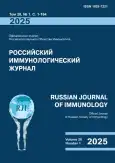Isolation of colony-forming cells from human blood and evaluation of population purity by flow cytometry
- Authors: Torgunakova E.A.1, Matveeva V.G.1, Antonova L.V.1
-
Affiliations:
- Research Institute for Complex Issues of Cardiovascular Diseases
- Issue: Vol 28, No 1 (2025)
- Pages: 43-48
- Section: SHORT COMMUNICATIONS
- URL: https://journal-vniispk.ru/1028-7221/article/view/277341
- DOI: https://doi.org/10.46235/1028-7221-16987-IOC
- ID: 277341
Cite item
Full Text
Abstract
Endothelial colony-forming cells (ECFCs) represent a rare population of circulating endothelial progenitor cells (EPCs), which is of interest for tissue engineering, cell therapy, and studying diseorders associated with endothelial dysfunction. Advances in this field imply isolation and pure culturing of endothelial colony-forming cells, which may be obtained from the mononuclear fraction of human peripheral blood. Flow cytometry may provide rather accurate phenotyping and checking purity of the cell cultures. The aim of this study was to obtain a population of colony-forming endothelial cells evaluated by flow cytometry in order to confirm the phenotype and assess the purity of the cell populations. Heparinized donor blood from peripheral vein was used to obtain ECFCs. The mononuclear cell fraction was isolated on a Histopaque 1077 density gradient. The obtained cells were cultured in complete nutrient medium EGM-2 MV with 5% FBS. On the 11th, 15th and 18th days of culture, the cells were detached with trypsin. Some cell aliquots were taken for flow cytometry, and the remaining cells were transferred to a plate for further cultivation until 70% confluency was reached. The phenotype of colonies obtained was evaluated by flow cytometry. Sample preparation of whole peripheral blood, mononuclear fraction and cell culture was performed using two panels of fluorochrome-labeled monoclonal antibodies. Colony growth was visually evaluated by phase-contrast microscopy. Statistical processing of the obtained results was performed using the applied program package “Statistica 6.0”. Up to 9 days, the cell colonies were not detectable visually. During further cultivation, the proliferating colonies of the “cobblestone” type were formed. Two populations were detected by flow cytometry: CD45+ and CD45-. In the course of our study, it was revealed that, with increasing cultivation terms, a decrease of CD45+ population was observed, along with progressive increase of CD45- cells, which may be associated with the gradual displacement of hematopoiesis cells by endothelial colony-forming cells. As a result of our study, the detected CD45+ population had a phenotype of hematopoietic lineage cells, whereas the CD45- population exhibited endothelial phenotype: CD31+CD309+vWF+CD146+. By 18 days, the purity of culture reached 97.6%.
Full Text
##article.viewOnOriginalSite##About the authors
E. A. Torgunakova
Research Institute for Complex Issues of Cardiovascular Diseases
Author for correspondence.
Email: evgeniyatorgunakova@mail.ru
Junior Research Associate, Laboratory of Cell Technologies
Russian Federation, KemerovoV. G. Matveeva
Research Institute for Complex Issues of Cardiovascular Diseases
Email: evgeniyatorgunakova@mail.ru
PhD (Medicine), Senior Research Associate, Laboratory of Cell Technologies
Russian Federation, KemerovoL. V. Antonova
Research Institute for Complex Issues of Cardiovascular Diseases
Email: evgeniyatorgunakova@mail.ru
PhD, MD (Medicine), Head, Laboratory of Cell Technologies
Russian Federation, KemerovoReferences
- Banno K., Yoder M.C. Tissue regeneration using endothelial colony-forming cells: promising cells for vascular repair. Pediatr. Res., 2018, Vol 83, no. 1-2, pp. 283-290.
- Colombo E., Calcaterra F., Cappelletti M., Mavilio D., Della Bella S. Comparison of fibronectin and collagen in supporting the isolation and expansion of endothelial progenitor cells from human adult peripheral blood. PloS One, 2013, Vol. 8, no. 6, e66734. doi: 10.1371/journal.pone.0066734.
- Go E., Yoder M.C. Identification of endothelial cells and their progenitors. Methods Mol. Biol., 2021, no. 2206, pp. 27-37.
- Lin Y., Weisdorf D.J., Solovey A., Hebbel R.P. Origins of circulating endothelial cells and endothelial outgrowth from blood. J. Clin. Invest., 2000, Vol. 105, no. 1, pp. 71-77.
- Medina R.J., Barber C.L., Sabatier F., Dignat-George F., Melero-Martin J.M., Khosrotehrani K., Ohneda O., Randi A.M., Chan J.K.Y., Yamaguchi T., van Hinsbergh V.W.M., Yoder M.C., Stitt A.W. Endothelial progenitors: a consensus statement on nomenclature. Stem Cells Transl. Med., 2017, Vol. 6, no. 5, pp. 1316-1320.
- Medina R.J., O’Neill C.L., Sweeney M., Guduric-Fuchs J., Gardiner T.A., Simpson D.A., Stitt A.W. Molecular analysis of endothelial progenitor cell (EPC) subtypes reveals two distinct cell populations with different identities. BMC Med. Genomics, 2010, Vol, 3, 18. doi: 10.1186/1755-8794-3-18.
- Melero-Martin J.M., Khan Z.A., Picard A., Wu X., Paruchuri S., Bischoff J. In vivo vasculogenic potential of human blood-derived endothelial progenitor cells. Blood, 2007, Vol. 109, no. 11, pp. 4761-4768.
- Moubarik C., Guillet B., Youssef B., Codaccioni J.L., Piercecchi M.D., Sabatier F., Lionel P., Dou L., Foucault-Bertaud A., Velly L., Dignat-George F., Pisano P. Transplanted late outgrowth endothelial progenitor cells as cell therapy product for stroke. Stem Cell Rev. Rep., 2011, Vol. 7, no. 1, pp. 208-220.
- Pober J.S., Sessa W.C. Evolving functions of endothelial cells in inflammation. Nat. Rev. Immunol., 2007, Vol. 7, no. 10, pp. 803-815.
Supplementary files









